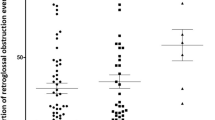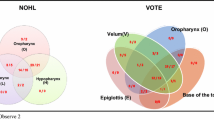Abstract
Purpose
Drug-induced sleep endoscopy (DISE) and sleep videofluoroscopy (SVF) are two dynamic modalities for evaluating the upper airway in patients with obstructive sleep apnea (OSA). We evaluated the correlation of obstructive sites determined by DISE and SVF in OSA patients and elucidate findings that can improve the accuracy of upper airway assessment.
Methods
A consecutive series of 63 patients with OSA who underwent DISE and SVF were the subjects of this study. The DISE and SVF findings were divided according to the anatomical structure responsible for the collapse, including the soft palate (SP), oropharyngeal lateral walls (LW), tongue base (TB), and larynx (LX). The obstruction was graded on the three-point scale: 0, no obstruction; 1, partial obstruction; or 2, complete obstruction. Additionally, grade 1.5 TB obstruction was designated when the posterior displacement of the anterior tongue was detected during simultaneous retropalatal obstruction. The agreement rate and Cohen’s kappa test between the two modalities were also assessed.
Results
The agreement rate between the two modalities was highest in LX (88.9%) followed by SP (85.7%), TB (76.1%), and LW (74.6%) (Cohen’s kappa value = 0.757 in LX, 0.642 in SP, 0.637 in TB, 0.612 in LW, respectively). When grade 1.5 and 2 TB obstructions were combined, the agreement rate increased to 88.9% (Cohen’s kappa value = 0.757).
Conclusions
We found a good overall agreement between the two dynamic airway evaluation modalities during drug-induced sleep, and this correlation may be improved if the posterior displacement of the anterior tongue during DISE is used as a sign of TB obstruction.
Similar content being viewed by others
References
Young T, Peppard PE, Gottlieb DJ (2002) Epidemiology of obstructive sleep apnea: a population health perspective. Am J Respir Crit Care Med 165:1217–1239
Kribbs NB, Pack AI, Kline LR, Smith PL, Schwartz AR, Schubert NM, Redline S, Henry JN, Getsy JE, Dinges DF (1993) Objective measurement of patterns of nasal CPAP use by patients with obstructive sleep apnea. Am Rev Respir Dis 147:887–895
Sin DD, Mayers I, Man GC, Pawluk L (2002) Long-term compliance rates to continuous positive airway pressure in obstructive sleep apnea: a population-based study. Chest 121:430–435
Lan MC, Hsu YB, Lan MY, Huang YC, Kao MC, Huang TT, Chiu TJ, Yang MC (2018) The predictive value of drug-induced sleep endoscopy for CPAP titration in OSA patients. Sleep Breath 22:949–954
Friedman M, Ibrahim H, Joseph NJ (2004) Staging of obstructive sleep apnea/hypopnea syndrome: a guide to appropriate treatment. Laryngoscope 114:454–459
Sher AE, Thorpy MJ, Shprintzen RJ, Spielman AJ, Burack B, McGregor PA (1985) Predictive value of Muller maneuver in selection of patients for uvulopalatopharyngoplasty. Laryngoscope 95:1483–1487
Terris DJ, Hanasono MM, Liu YC (2000) Reliability of the Muller maneuver and its association with sleep-disordered breathing. Laryngoscope 110:1819–1823
Poirrier AL, Pire S, Raskin S, Limme M, Poirrier R (2012) Contribution of postero-anterior cephalometry in obstructive sleep apnea. Laryngoscope 122:2350–2354
Julia-Serda G, Perez-Penate G, Saavedra-Santana P et al (2006) Usefulness of cephalometry in sparing polysomnography of patients with suspected obstructive sleep apnea. Sleep Breath 10:181–187
Bhattacharyya N, Blake SP, Fried MP (2000) Assessment of the airway in obstructive sleep apnea syndrome with 3-dimensional airway computed tomography. Otolaryngol Head Neck Surg 123:444–449
Donnelly LF, Casper KA, Chen B, Koch BL (2002) Defining normal upper airway motion in asymptomatic children during sleep by means of cine MR techniques. Radiology 223:176–180
Ravesloot MJ, de Vries N (2011) One hundred consecutive patients undergoing drug-induced sleep endoscopy: results and evaluation. Laryngoscope 121:2710–2716
De Vito A, Agnoletti V, Berrettini S et al (2011) Drug-induced sleep endoscopy: conventional versus target controlled infusion techniques—a randomized controlled study. Eur Arch Otorhinolaryngol 268:457–462
Kezirian EJ, White DP, Malhotra A, Ma W, McCulloch CE, Goldberg AN (2010) Interrater reliability of drug-induced sleep endoscopy. Arch Otolaryngol Head Neck Surg 136:393–397
Rodriguez-Bruno K, Goldberg AN, McCulloch CE, Kezirian EJ (2009) Test-retest reliability of drug-induced sleep endoscopy. Otolaryngol Head Neck Surg 140:646–651
Kim DK, Lee WH, Lee CH, Rhee CS, Kim JW (2014) Interrater reliability of sleep videofluoroscopy for airway obstruction in obstructive sleep apnea. Laryngoscope 124:1267–1271
Lee CH, Hong SL, Rhee CS, Kim SW, Kim JW (2012) Analysis of upper airway obstruction by sleep videofluoroscopy in obstructive sleep apnea: a large population-based study. Laryngoscope 122:237–241
Lee CH, Kim JW, Lee HJ, Yun PY, Kim DY, Seo BS, Yoon IY, Mo JH (2009) An investigation of upper airway changes associated with mandibular advancement device using sleep videofluoroscopy in patients with obstructive sleep apnea. Arch Otolaryngol Head Neck Surg 135:910–914
Lee CH, Mo JH, Kim BJ, Kong IG, Yoon IY, Chung S, Kim JH, Kim JW (2009) Evaluation of soft palate changes using sleep videofluoroscopy in patients with obstructive sleep apnea. Arch Otolaryngol Head Neck Surg 135:168–172
Lee CH, Kim JW, Lee HJ, Seo BS, Yun PY, Kim DY, Yoon IY, Rhee CS, Park JW, Mo JH (2010) Determinants of treatment outcome after use of the mandibular advancement device in patients with obstructive sleep apnea. Arch Otolaryngol Head Neck Surg 136:677–681
Lee CH, Kim DK, Kim SY, Rhee CS, Won TB (2015) Changes in site of obstruction in obstructive sleep apnea patients according to sleep position: a DISE study. Laryngoscope 125:248–254
Kezirian EJ, Hohenhorst W, de Vries N (2011) Drug-induced sleep endoscopy: the VOTE classification. Eur Arch Otorhinolaryngol 268:1233–1236
Landis JR, Koch GG (1977) The measurement of observer agreement for categorical data. Biometrics 33:159–174
Caples SM, Rowley JA, Prinsell JR, Pallanch JF, Elamin MB, Katz SG, Harwick JD (2010) Surgical modifications of the upper airway for obstructive sleep apnea in adults: a systematic review and meta-analysis. Sleep 33:1396–1407
Cavaliere M, Russo F, Iemma M (2013) Awake versus drug-induced sleep endoscopy: evaluation of airway obstruction in obstructive sleep apnea/hypopnoea syndrome. Laryngoscope 123:2315–2318
George JR, Chung S, Nielsen I, Goldberg AN, Miller A, Kezirian EJ (2012) Comparison of drug-induced sleep endoscopy and lateral cephalometry in obstructive sleep apnea. Laryngoscope 122:2600–2605
Eichler C, Sommer JU, Stuck BA, Hormann K, Maurer JT (2013) Does drug-induced sleep endoscopy change the treatment concept of patients with snoring and obstructive sleep apnea? Sleep Breath 17:63–68
Soares D, Folbe AJ, Yoo G, Badr MS, Rowley JA, Lin HS (2013) Drug-induced sleep endoscopy vs awake Muller's maneuver in the diagnosis of severe upper airway obstruction. Otolaryngol Head Neck Surg 148:151–156
Gregorio MG, Jacomelli M, Inoue D, Genta PR, de Figueiredo AC, Lorenzi-Filho G (2011) Comparison of full versus short induced-sleep polysomnography for the diagnosis of sleep apnea. Laryngoscope 121:1098–1103
Author information
Authors and Affiliations
Corresponding authors
Ethics declarations
Conflict of interest
The authors declare that they have no conflict of interest.
Research involving human participants and/or animals
All procedures performed in studies involving human participants were in accordance with the ethical standards of the institutional and/or national research committee and with the 1964 Helsinki declaration and its later amendments or comparable ethical standards.
Informed consent
Informed consent was obtained from all individual participants included in the study.
Additional information
Publisher’s note
Springer Nature remains neutral with regard to jurisdictional claims in published maps and institutional affiliations.
Rights and permissions
About this article
Cite this article
Won, TB., Kim, DK., Wee, J.H. et al. Correlation of site of obstruction between two dynamic evaluation modalities in obstructive sleep apnea patients: drug-induced sleep endoscopy and sleep videofluoroscopy. Sleep Breath 25, 1587–1592 (2021). https://doi.org/10.1007/s11325-020-02225-8
Received:
Revised:
Accepted:
Published:
Issue Date:
DOI: https://doi.org/10.1007/s11325-020-02225-8




